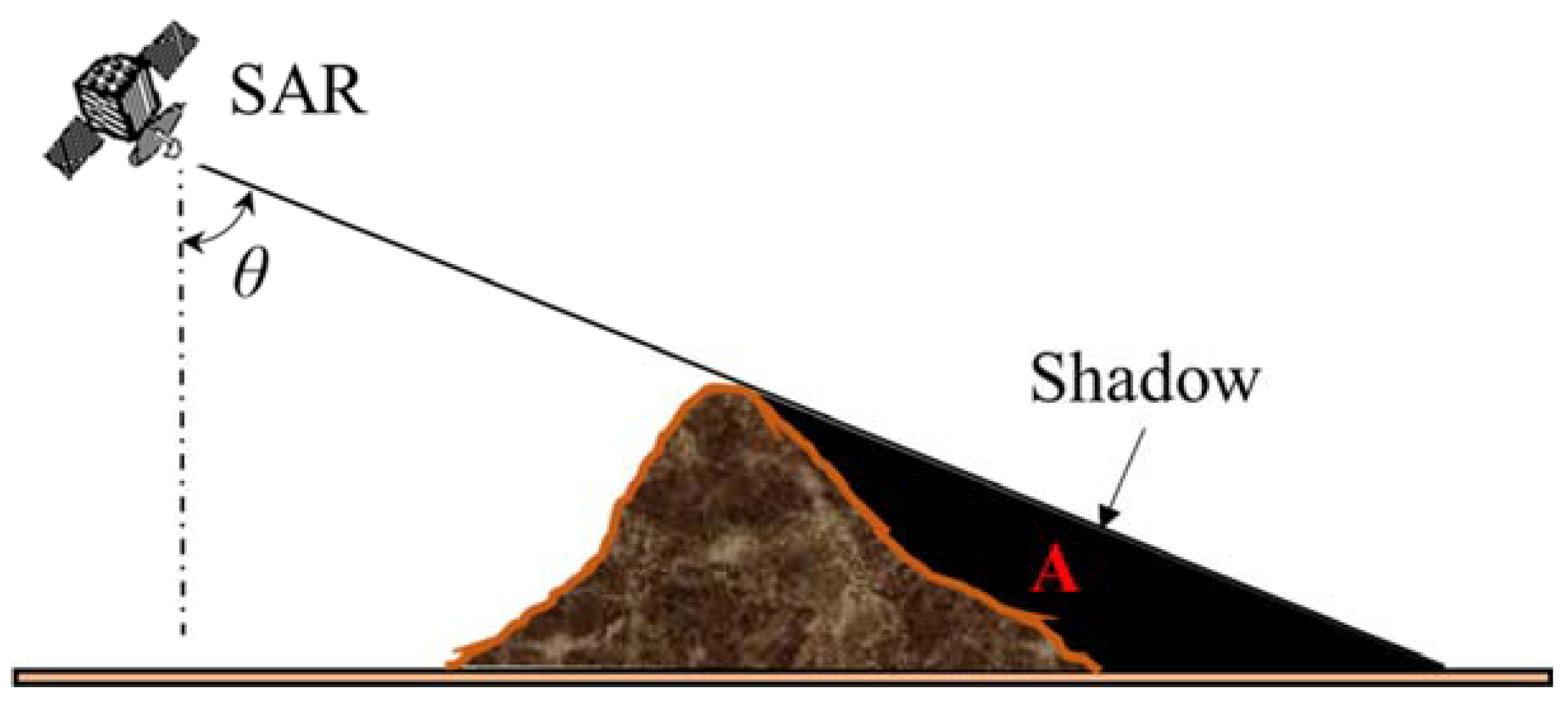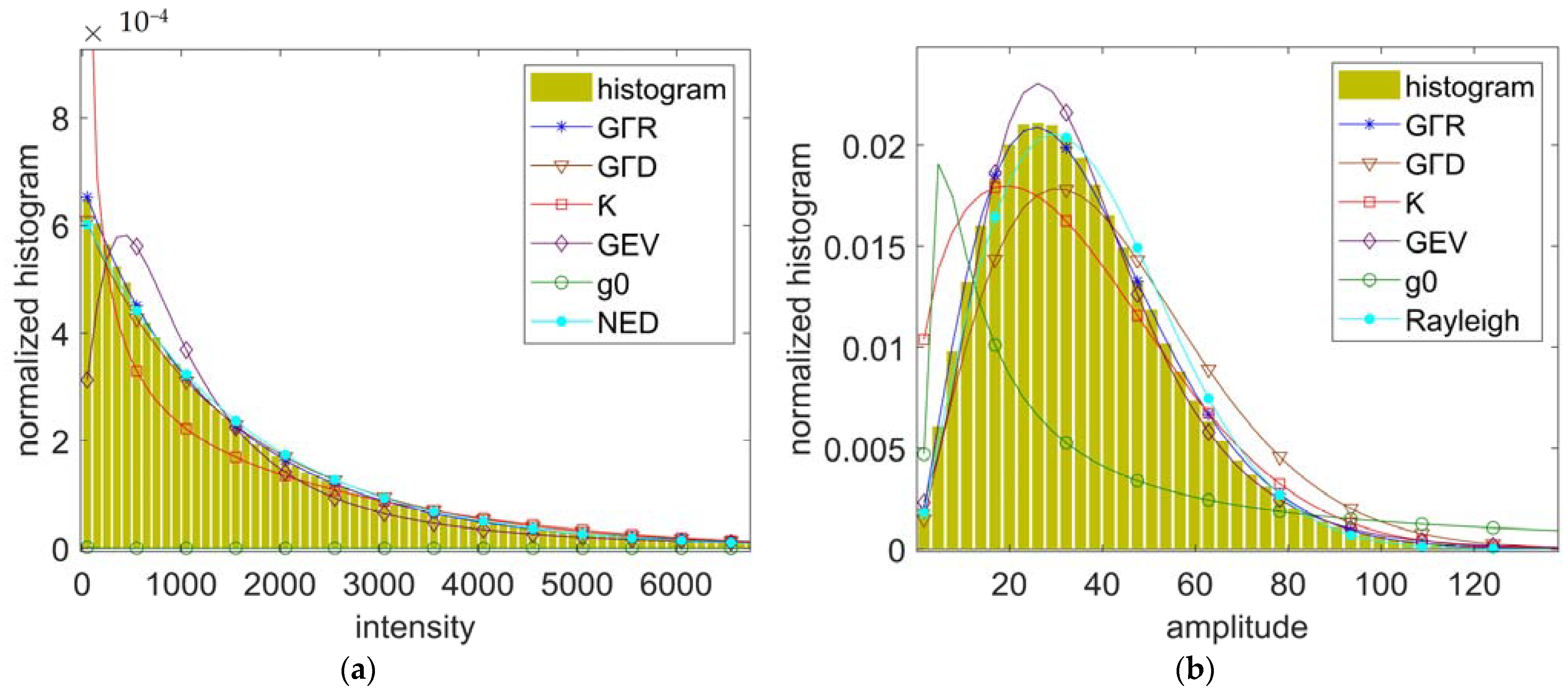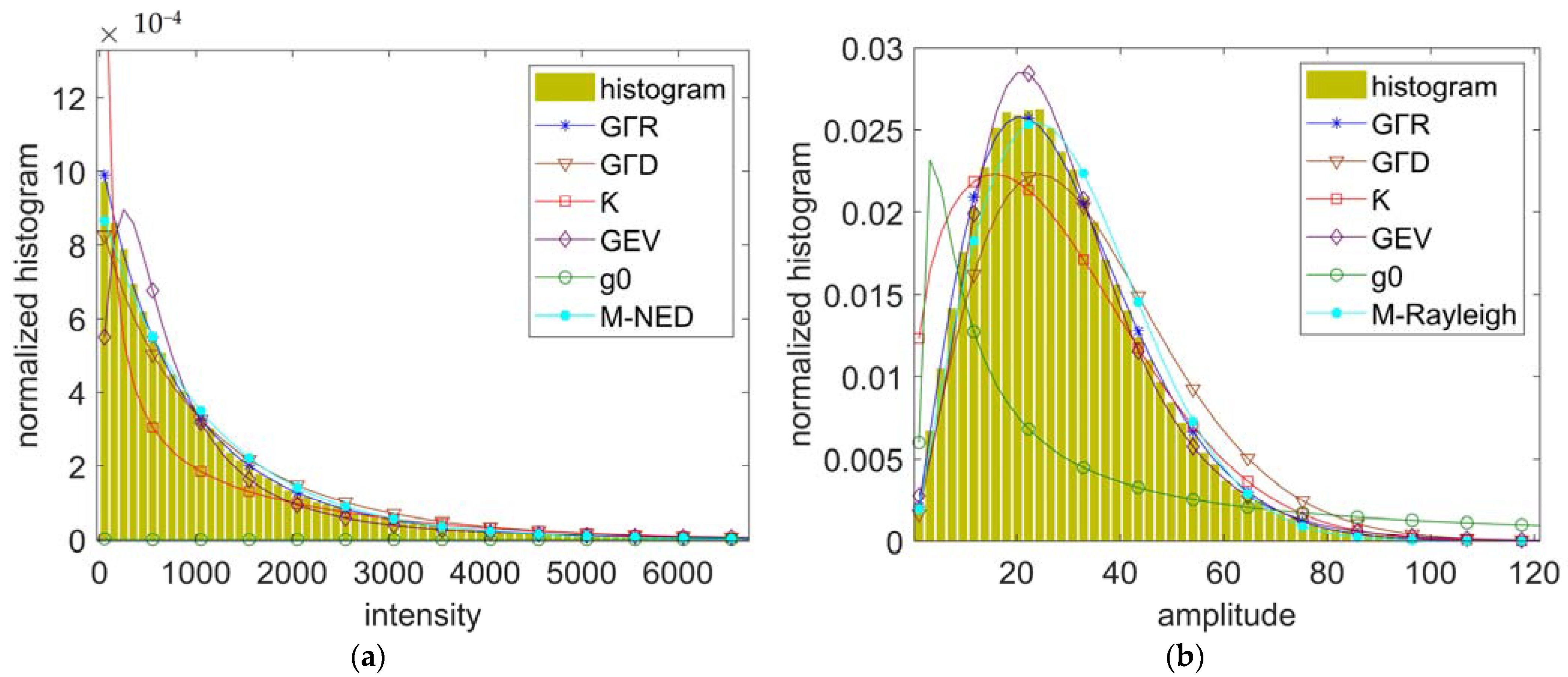Statistical Modeling of Shadows in SAR Imagery
Abstract
:1. Introduction
2. Shadow Formation and Expression
3. Statistical Modeling of Single-Look SAR Image Shadow
4. Statistical Modeling of Multilook SAR Image Shadow
4.1. Modeling of SAR Image Shadow Multilooked in Real Domain
4.2. Modeling of SAR Image Shadow Multilooked in Complex Domain
5. Modeling of Filtered SAR Image Shadow
6. Experimental Results and Discussion
6.1. Experimental Data and Scheme
6.2. Chi-Square Goodness-of-Fit Tests of Deduced Models
6.3. Experiment on Single-Look SAR Image Shadow
6.4. Experiment on SAR Image Shadow Multilooked in Real Domain
6.5. Experiment on SAR Image Shadow Multilooked in Complex Domain
6.6. Experiment on Filtered SAR Image Shadow
7. Conclusions
Author Contributions
Funding
Data Availability Statement
Acknowledgments
Conflicts of Interest
References
- Papson, S.; Narayanan, R.M. Classification via the shadow region in SAR imagery. IEEE Trans. Aero. Elec. Syst. 2012, 48, 969–980. [Google Scholar] [CrossRef]
- Gao, F.; You, J.; Wang, J.; Sun, J.; Yang, E.; Zhou, H. A novel target detection method for SAR images based on shadow proposal and saliency analysis. Neurocomputing 2017, 267, 220–231. [Google Scholar] [CrossRef]
- Li, H.; Yu, X.; Tang, Y.; Wang, X. Shadow detection in SAR images based on greyscale distribution, a saliency model, and geometrical matching. Int. J. Remote Sens. 2020, 41, 7446–7471. [Google Scholar] [CrossRef]
- Xu, H.; Yang, Z.; Tian, M.; Sun, Y.; Liao, G. An extended moving target detection approach for high-resolution multichannel SAR-GMTI systems based on enhanced shadow-aided decision. IEEE Trans. Geosci. Remote Sens. 2017, 56, 715–729. [Google Scholar] [CrossRef]
- Shang, S.; Wu, F.; Zhou, Y.; Liu, Z. Moving Target Velocity Estimation of Video SAR Based on Shadow Detection. In Proceedings of the 2020 Cross Strait Radio Science and Wireless Technology Conference (CSRSWTC), Fuzhou, China, 13–16 December 2020; pp. 1–3. [Google Scholar] [CrossRef]
- Zhong, C.; Zhang, Y.; Ding, J. A Shadow-based Method for Moving Target Detection in Video SAR. In Proceedings of the EUSAR 2021, 13th European Conference on Synthetic Aperture Radar, Online, 29 March–1 April 2021; pp. 1–6. [Google Scholar]
- Zhao, B.; Han, Y.; Wang, H.; Tang, L.; Liu, X.; Wang, T. Robust shadow tracking for video SAR. IEEE Geosci. Remote Sens. Lett. 2020, 18, 821–825. [Google Scholar] [CrossRef]
- Lin, Y.; Zhang, H.; Li, G.; Wang, T.; Wan, L.; Lin, H. Improving impervious surface extraction with shadow-based sparse representation from optical, SAR, and LiDAR data. IEEE J. Sel. Topic. Applic. Earth. Observ. Remote Sens. 2019, 12, 2417–2428. [Google Scholar] [CrossRef]
- Lin, Y.; Zhang, H.; Ma, P.; Li, Y. Multisource Shadow-Based Fuzzy Set (MSFS) Approach for Impervious Surfaces Mapping from Optical and SAR Data. In Proceedings of the 2021 IEEE International Geoscience and Remote Sensing Symposium (IGARSS), Brussels, Belgium, 11–16 July 2021; pp. 6817–6820. [Google Scholar] [CrossRef]
- Bouvet, A.; Mermoz, S.; Ballère, M.; Koleck, T.; Le Toan, T. Use of the SAR shadowing effect for deforestation detection with Sentinel-1 time series. Remote Sens. 2018, 10, 1250. [Google Scholar] [CrossRef]
- Zhang, Y.; Meng, X.M.; Dijkstra, T.A.; Jordan, C.J.; Chen, G.; Zeng, R.Q.; Novellino, A. Forecasting the magnitude of potential landslides based on InSAR techniques. Remote Sens. Environ. 2020, 241, 111738. [Google Scholar] [CrossRef]
- Guo, R.; Li, S.; Chen, Y.N.; Li, X.; Yuan, L. Identification and monitoring landslides in Longitudinal Range-Gorge Region with InSAR fusion integrated visibility analysis. Landslides 2021, 18, 551–568. [Google Scholar] [CrossRef]
- Cumming, I.G.; Wong, F.H. Digital Processing of Synthetic Aperture Radar Data: Algorithms and Implementation; Artech House, Inc.: Norwood, MA, USA, 2005. [Google Scholar]
- Gao, G. Statistical modeling of SAR images: A survey. Sensors 2010, 10, 775–795. [Google Scholar] [CrossRef]
- Frery, A.C.; Muller, H.J.; Yanasse, C.D.C.F.; Sant’Anna, S.J.S. A model for extremely heterogeneous clutter. IEEE Trans. Geosci. Remote Sens. 1997, 35, 648–659. [Google Scholar] [CrossRef]
- Lee, J.S.; Hoppel, K.; Mango, S.A. Unsupervised estimation of speckle noise in radar images. Int. J. Imaging Syst. Technol. 1992, 4, 298–305. [Google Scholar] [CrossRef]
- Goodman, J.W. Some fundamental properties of speckle. J. Opt. Soc. Amer. 1976, 66, 1145–1150. [Google Scholar] [CrossRef]
- Delignon, Y.; Pieczynski, W. Modeling non-Rayleigh speckle distribution in SAR images. IEEE Trans. Geosci. Remote Sens. 2002, 40, 1430–1435. [Google Scholar] [CrossRef]
- Oliver, C.; Quegan, S. Understanding Synthetic Aperture Radar Images; SciTech Publishing: Raleigh, NC, USA, 2004. [Google Scholar]
- Li, H.C.; Hong, W.; Wu, Y.R.; Fan, P.Z. An efficient and flexible statistical model based on generalized gamma distribution for amplitude SAR images. IEEE Trans. Geosci. Remote Sens. 2010, 48, 2711–2722. [Google Scholar] [CrossRef]
- Jakeman, E. On the statistics of K-distributed noise. J. Phys. A Math. Gen. 1980, 13, 31–48. [Google Scholar] [CrossRef]
- Chitroub, S.; Houacine, A.; Sansal, B. Statistical characterisation and modelling of SAR images. Signal Proc. 2002, 82, 69–92. [Google Scholar] [CrossRef]
- Moser, G.; Zerubia, J.; Serpico, S.B. SAR amplitude probability density function estimation based on a generalized Gaussian model. IEEE Trans. Image Proc. 2006, 15, 1429–1442. [Google Scholar] [CrossRef] [PubMed]
- Li, H.C.; Hong, W.; Wu, Y.R.; Fan, P.Z. On the empirical-statistical modeling of SAR images with generalized gamma distribution. IEEE J. Sel. Topic. Sig. Proc. 2011, 5, 386–397. [Google Scholar] [CrossRef]
- Trunk, G.V.; George, S.F. Detection of targets in non-Gaussian sea clutter. IEEE Trans. Aero. Elec. Sys. 1970, 6, 620–628. [Google Scholar] [CrossRef]
- Schleher, D.C. Radar detection in Weibull clutter. IEEE Trans. Aero. Elec. Sys. 1976, 12, 736–743. [Google Scholar] [CrossRef]
- Tison, C.; Nicolas, J.M.; Tupin, F.; Maître, H. A new statistical model for Markovian classification of urban areas in high-resolution SAR images. IEEE Trans. Geosci. Remote Sens. 2004, 42, 2046–2057. [Google Scholar] [CrossRef]
- Duda, R.O.; Hart, P.E.; Stork, D.G. Pattern Classification, 2nd ed.; Wiley: New York, NY, USA, 1997. [Google Scholar]
- Peng, S.; Qu, C.; Li, J. Improved kN Nearest Neighbor Estimation Algorithm for SAR Image Clutter Statistical Modeling. In Proceedings of the 2019 4th International Conference on Information Systems Engineering (ICISE), Shanghai, China, 4–6 May 2019; pp. 87–90. [Google Scholar] [CrossRef]
- Bruzzone, L.; Marconcini, M.; Wegmuller, U.; Wiesmann, A. An advanced system for the automatic classification of multitemporal SAR images. IEEE Trans. Geosci. Remote Sens. 2004, 42, 1321–1334. [Google Scholar] [CrossRef]
- Mantero, P.; Moser, G.; Serpico, S.B. Partially supervised classification of remote sensing images through SVM-based probability density estimation. IEEE Trans. Geosci. Remote Sens. 2005, 43, 559–570. [Google Scholar] [CrossRef]
- Tipping, M.E. Sparse Bayesian learning and the relevance vector machine. J. Mach. Learn. Res. 2001, 1, 211–244. [Google Scholar]
- McLachlan, G.J.; Peel, D. Finite Mixture Models; Jon & Son: New York, NY, USA, 2000. [Google Scholar]
- Huang, S.; Zebker, H.A. SAR Image Statistics by Bandwidth Using a Mixture Distribution of Persistent Scatterer and Clutter Distributions. In Proceedings of the 2019–2019 IEEE International Geoscience and Remote Sensing Symposium (IGARSS), Yokohama, Japan, 28 July–2 August 2019; pp. 2965–2968. [Google Scholar] [CrossRef]
- Lee, J.S.; Pottier, E. Polarimetric Radar Imaging: From Basics to Applications; CRC Press: Boca Raton, FL, USA, 2017. [Google Scholar]
- Curlander, J.C.; McDonough, R.N. Synthetic Aperture Radar; Wiley: New York, NY, USA, 1991; Volume 11. [Google Scholar]
- Lee, J.S. Digital image enhancement and noise filtering by use of local statistics. IEEE Trans. Pattern Anal. Mach. Intell. 1980, 2, 165–168. [Google Scholar] [CrossRef]
- Kotz, S.; Nadarajah, S. Extreme Value Distributions: Theory and Applications; World Scientific: Singapore, 2000. [Google Scholar]
- El Adlouni, S.; Ouarda, T.B.; Zhang, X.; Roy, R.; Bobée, B. Generalized maximum likelihood estimators for the nonstationary generalized extreme value model. Water Resour. Res. 2007, 43, 1–13. [Google Scholar] [CrossRef]
- MartÍnez-UsÓMartinez-Uso, A.; Pla, F.; Sotoca, J.M.; García-Sevilla, P. Clustering-based hyperspectral band selection using information measures. IEEE Trans. Geosci. Romote Sens. 2007, 45, 4158–4171. [Google Scholar] [CrossRef]






| Model Families | Model | Relationship | Application Cases |
|---|---|---|---|
| Physical mechanism models | g | Including κ, g0 (or Fisher) | Homogeneous, heterogeneous, or extremely heterogeneous region; multi- or single-look; intensity or amplitude |
| GΓD | Including LN, Weibull, Rayleigh, negative exponential, Nakagami, Gamma | Homogeneous region; moderately high resolution or high resolution; multi- or single-look; intensity or amplitude | |
| GΓR | Including Rayleigh, GGR | Moderately high resolution or high resolution; homogeneous or heterogeneous region; multi- or single-look amplitude | |
| Data-driven models | LN | — | Moderately high resolution; amplitude |
| Weibull | Including Rayleigh, negative exponential | High resolution; amplitude or intensity; single-look | |
| Fisher | Equivalent to g0 | Homogeneous, heterogeneous, or extremely heterogeneous region; multi- or single-look; intensity or amplitude |
| Samples | n = 10,000 | n = 20,000 | n = 50,000 | n = 100,000 | ||||
|---|---|---|---|---|---|---|---|---|
| Chi-Square Stat | p-Value | Chi-Square Stat | p-Value | Chi-Square Stat | p-Value | Chi-Square Stat | p-Value | |
| NED | 5.7573 | 0.9278 (r = 12) | 10.9234 | 0.6172 (r = 13) | 17.6603 | 0.2809 (r = 15) | 20.6354 | 0.1922 (r = 16) |
| Rayleigh | 9.2035 | 0.6855 (r = 12) | 14.8233 | 0.3185 (r = 13) | 19.9137 | 0.1753 (r = 15) | 21.0974 | 0.1748 (r = 16) |
| M-NED | 7.7898 | 0.8013 (r = 12) | 13.5467 | 0.4065 (r = 13) | 16.3543 | 0.3589 (r = 15) | 22.1802 | 0.1375 (r = 16) |
| M-Rayleigh | 8.3445 | 0.7577 (r = 12) | 10.6023 | 0.6441 (r = 13) | 19.9641 | 0.1733 (r = 15) | 21.3512 | 0.1654 (r = 16) |
| GEV | 7.2102 | 0.7055 (r = 10) | 9.3685 | 0.5879 (r = 11) | 16.0199 | 0.2481 (r = 13) | 21.0521 | 0.1003 (r = 14) |
| Gamma | / | / | / | / | ||||
| Nakagami | / | / | / | / | ||||
| Distribution | Intensity | Amplitude |
|---|---|---|
| NED | 0.0000316 | — |
| Rayleigh | — | 0.0037223 |
| GΓR | 0.0000074 | 0.0006900 |
| GΓD | 0.0000204 | 0.0101596 |
| κ | 0.0004125 | 0.0142517 |
| g0 | 0.0326374 | 0.1551140 |
| GEV | 0.0002549 | 0.0010526 |
| Distribution | Intensity | Amplitude |
|---|---|---|
| Gamma | 0.000242 | — |
| Nakagami | — | 0.016177 |
| GΓR | 0.000009 | 0.000934 |
| GΓD | 0.562952 | F |
| κ | 0.002410 | 0.046220 |
| g0 | 0.000610 | 0.009446 |
| GEV | 0.000035 | 0.000246 |
| Distribution | Intensity | Amplitude |
|---|---|---|
| M-NED | 0.000066 | — |
| M-Rayleigh | — | 0.005537 |
| GΓR | 0.000010 | 0.001119 |
| GΓD | 0.000127 | 0.014428 |
| κ | 0.000826 | 0.020225 |
| g0 | 0.000484 | 0.225945 |
| GEV | 0.000234 | 0.000288 |
| Image | GEV | GΓR | GΓD | κ | g0 | |
|---|---|---|---|---|---|---|
| Intensity | Single-look | 0.000012 | 0.000054 | 1.682804 | 0.003711 | 0.000186 |
| Multilook | 0.000004 | 0.000131 | F | 0.003649 | 0.000101 | |
| Amplitude | Single-look | 0.000135 | 0.004880 | 0.202100 | 0.067226 | 0.001377 |
| Multilook | 0.000690 | 0.016712 | F | 0.062596 | 0.002651 | |
Disclaimer/Publisher’s Note: The statements, opinions and data contained in all publications are solely those of the individual author(s) and contributor(s) and not of MDPI and/or the editor(s). MDPI and/or the editor(s) disclaim responsibility for any injury to people or property resulting from any ideas, methods, instructions or products referred to in the content. |
© 2023 by the authors. Licensee MDPI, Basel, Switzerland. This article is an open access article distributed under the terms and conditions of the Creative Commons Attribution (CC BY) license (https://creativecommons.org/licenses/by/4.0/).
Share and Cite
Luo, X.; Zhang, X.; Bao, J.; Chang, L.; Xi, W. Statistical Modeling of Shadows in SAR Imagery. Mathematics 2023, 11, 4437. https://doi.org/10.3390/math11214437
Luo X, Zhang X, Bao J, Chang L, Xi W. Statistical Modeling of Shadows in SAR Imagery. Mathematics. 2023; 11(21):4437. https://doi.org/10.3390/math11214437
Chicago/Turabian StyleLuo, Xiaojun, Xiangyang Zhang, Jiawen Bao, Ling Chang, and Weixin Xi. 2023. "Statistical Modeling of Shadows in SAR Imagery" Mathematics 11, no. 21: 4437. https://doi.org/10.3390/math11214437





